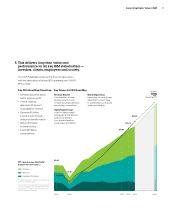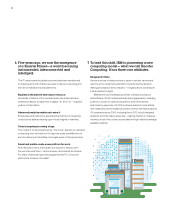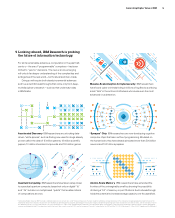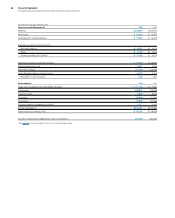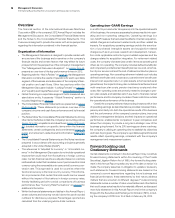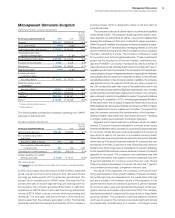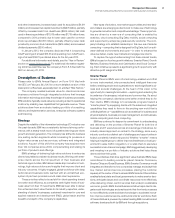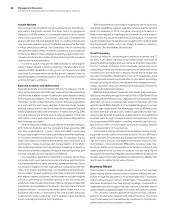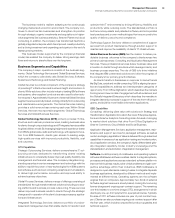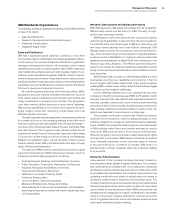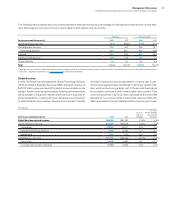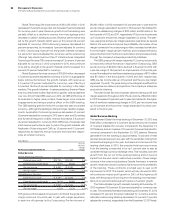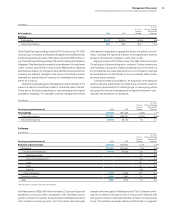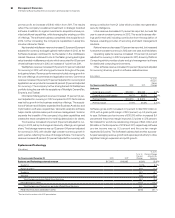IBM 2012 Annual Report Download - page 22
Download and view the complete annual report
Please find page 22 of the 2012 IBM annual report below. You can navigate through the pages in the report by either clicking on the pages listed below, or by using the keyword search tool below to find specific information within the annual report.
21
Management Discussion
International Business Machines Corporation and Subsidiary Companies
and other investments, increased cash used for acquisitions ($1,911
million) and increased net capital investments ($248 million), partially
offset by increased cash from divestitures ($585 million). Net cash
used in financing activities of $11,976 million was $1,719 million lower,
compared to 2011, primarily due to lower cash used for common
stock repurchases ($3,051 million), partially offset by lower cash
provided by common stock transactions ($914 million) and increased
dividend payments ($300 million).
In January 2013, the company disclosed that it is expecting
GAAP earnings of at least $15.53 and operating (non-GAAP) earn-
ings of at least $16.70 per diluted share for the full year 2013.
For additional information and details, see the “Year in Review”
section on pages 26 through 43. For additional information regard-
ing 2002 free cash flow, see the company’s Form 8-K filed with the
SEC on January 22, 2013.
Description of Business
Please refer to IBM’s Annual Report on Form 10-K filed with
the SEC on February 26, 2013 for a more detailed version of this
Des cription of Business, especially Item 1A. entitled “Risk Factors.”
The company creates business value for clients and solves
business problems through integrated solutions that leverage
information technology and deep knowledge of business processes.
IBM solutions typically create value by reducing a client’s operational
costs or by enabling new capabilities that generate revenue. These
solutions draw from an industry-leading portfolio of consulting,
delivery and implementation services, enterprise software, systems
and financing.
Strategy
Despite the volatility of the information technology (IT) industry over
the past decade, IBM has consistently delivered strong perfor-
mance, with a steady track record of sustained earnings per share
growth and cash generation. The company has shifted its business
mix, exiting certain segments while increasing its presence in
higher-value areas such as services, software and integrated
solutions. As part of this shift, the company has acquired more
than 140 companies since 2000, complementing and scaling its
portfolio of products and offerings.
IBM’s strategy of delivering high value solutions to enterprise
clients has yielded consistent business results. Working with enter-
prise clients across the full spectrum of their business and
technical opportunities, IBM delivers leadership innovation in tech-
nology, high value solutions and insights that improve client and
industry outcomes. A highly engaged, global workforce with deep
technical and business skills, teamed with an unmatched eco-
system of partners provides a world-class client experience.
These priorities reflect a broad shift in client spending toward
innovation and efficiency, as companies seek higher levels of busi-
ness value from their IT investments. IBM has been able to deliver
this enhanced client value thanks to its industry expertise, under-
standing of clients’ businesses, sustained investment in core and
applied research and development (R&D), global reach and the
breadth and depth of the company’s capabilities.
New types of solutions, new market opportunities and new deci-
sion makers are emerging as clients look to make use of technology
to generate innovation and competitive advantage. These opportuni-
ties are driven by a new era of computing that is enabled by
analytics, cloud computing, Big Data, mobility, social computing
and supported by enterprise grade security solutions. The com-
pany’s strategy is to establish leadership in this new era of smarter
computing—computing that is designed for Big Data, built on soft-
ware-defined environments and open—in order to enhance the
value we deliver, create new markets and engage new clients.
To capture the opportunities arising from these market trends,
IBM is focused on four key growth initiatives: Smarter Planet, Growth
Markets, Business Analytics and Optimization and Cloud Comput-
ing. Each initiative represents a significant growth opportunity with
attractive profit margins for IBM.
Smarter Planet
Smarter Planet is IBM’s vision of a technology-enabled world that
is more instrumented, interconnected and intelligent than ever
before, enabling people and organizations to tackle significant busi-
ness and societal challenges. At the heart of this vision is the
opportunity for meaningful innovation—exploring and extending the
boundaries of businesses, industries and communities. It’s about
helping the company’s clients become better at what they do for
their clients. IBM’s strategy is to accelerate progress toward a
“smarter planet” by equipping clients with the advanced, integrated
capabilities they need to thrive in this exciting new world that is
unfolding before us—capabilities such as analytics for business and
physical systems, business process management, social business,
mobile computing and cloud computing.
IBM has continued to deepen its commitment to understanding
and delivering on the promise of Smarter Planet for both line of
business and IT executives across a broad range of industries. An
industry-based approach is central to the strategy, since every
industry confronts a distinct set of challenges and opportunities in
today’s constantly transforming world. Whether “smarter” means
helping a hospital group to deliver improved healthcare, a local gov-
ernment to ease traffic congestion, or a retail chain to execute a
successful cross-channel campaign, IBM is aggressively developing
and investing in a portfolio of industry solutions that helps these
clients achieve their goals.
Three initiatives that drive significant value illustrate IBM’s deep
commitment to building a smarter planet: Smarter Commerce,
Smarter Cities and Social Business. IBM’s Smarter Commerce model
integrates and transforms how companies manage and adapt their
buy, market, sell and service processes, placing the customer
squarely at the center of their business. IBM’s Smarter Cities initiative
enables federal, state and local governments to make smarter deci-
sions, anticipate issues and coordinate resources more effectively,
while delivering citizen-centric services that underpin sustainable
economic growth. IBM’s Social Business initiative helps clients inte-
grate social technologies and practices into their front-end processes
to more effectively create and share knowledge to accelerate innova-
tion, improve customer service, and build a smarter workforce. Each
of these initiatives is powered by market-leading IBM innovations and
software, developed both by IBM and through acquisitions.


